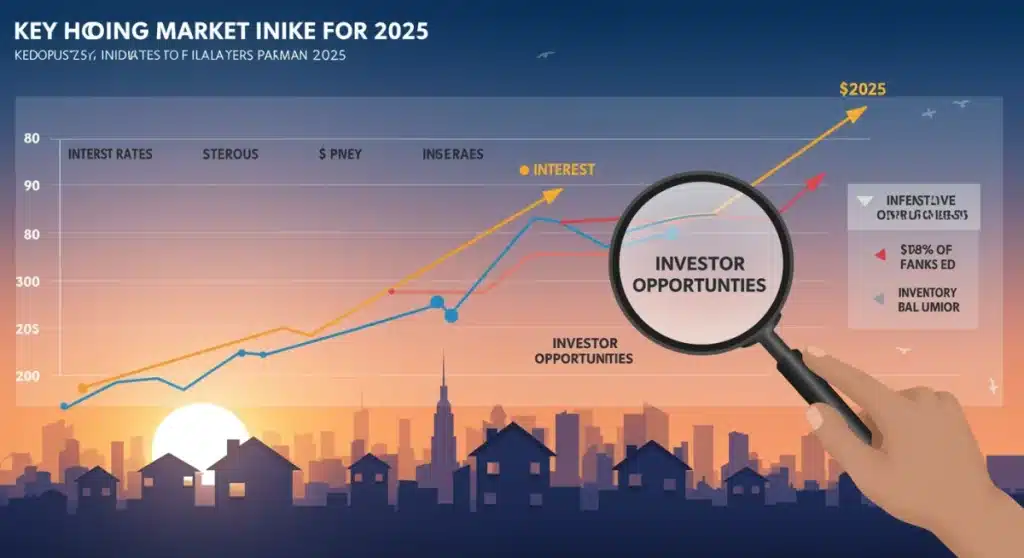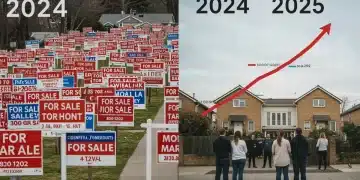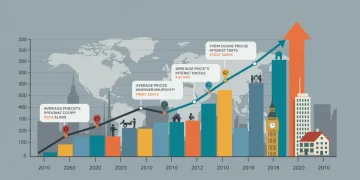Housing Market Forecast 2025: Key Trends & Investor Opportunities

The 2025 housing market forecast indicates shifting dynamics with potential for both challenges and strategic opportunities. Investors should monitor interest rates, inventory levels, and demographic shifts to capitalize on emerging trends.
The Housing Market Forecast 2025: Key Trends and Opportunities for Investors (RECENT UPDATES) is rapidly evolving, presenting both challenges and strategic openings for those engaged in real estate. Recent developments indicate a dynamic landscape influenced by economic shifts, policy adjustments, and changing consumer behaviors. Understanding these nuances is crucial for navigating the market effectively.
Understanding Current Market Dynamics as of Late 2024
As of late 2024, the housing market continues to grapple with a complex interplay of factors. High interest rates have significantly impacted affordability, cooling buyer demand in many regions. However, persistent inventory shortages in desirable areas maintain upward pressure on prices, creating a bifurcated market where some segments remain competitive while others experience a slowdown. This current environment sets the stage for the anticipated shifts in 2025.
Interest Rate Trajectories
The Federal Reserve’s stance on interest rates remains a primary driver of market activity. Recent signals suggest a potential stabilization, or even slight decrease, in rates as inflation shows signs of moderation. This outlook is critical for prospective buyers and investors alike.
- Federal Reserve Policy: Current indications point to a cautious approach, with future rate adjustments tied to economic data.
- Mortgage Rate Volatility: Mortgage rates are expected to mirror bond market movements, offering periods of slight relief.
- Impact on Affordability: Even minor rate changes can significantly alter monthly payments, influencing buyer behavior.
Inventory Levels and Supply Chains
Supply chain issues, while improved from peak pandemic disruptions, still affect new home construction. The existing home market continues to face a shortage of listings, partially due to homeowners locked into lower mortgage rates reluctant to sell. This imbalance between supply and demand is a core characteristic of the current market.
New construction efforts are attempting to bridge the gap, but labor shortages and rising material costs present ongoing hurdles. The pace of new builds is critical for alleviating price pressures, especially in high-growth metropolitan areas.
Key Economic Indicators Shaping the 2025 Outlook
Several macroeconomic indicators are poised to heavily influence the housing market forecast 2025. Inflation, employment rates, and GDP growth are interconnected variables that directly impact consumer confidence and purchasing power. Monitoring these indicators provides essential insights into future market direction.
Inflation Trends and Consumer Spending
Inflation, while moderating, remains a concern. Persistent inflation erodes purchasing power, affecting savings and the ability to afford housing. Consumer spending, a key component of economic growth, can also be dampened by inflationary pressures, leading to a more cautious approach to large investments like homes.
Analysts are closely watching core inflation metrics, excluding volatile food and energy prices, for a clearer picture of underlying price stability. A sustained downtrend in inflation would likely pave the way for more favorable lending conditions.
Employment and Wage Growth
Robust employment figures and steady wage growth are fundamental pillars supporting housing demand. A strong job market ensures a steady stream of potential buyers with the income necessary for homeownership. Conversely, any significant slowdown in job creation or wage stagnation could dampen demand.
Recent job reports indicate a resilient labor market, though some sectors are experiencing shifts. The interplay between job availability and wage increases will be a critical factor in determining housing market vibrancy in 2025.
Demographic Shifts and Their Impact on Housing Demand
Demographic trends are long-term drivers that will significantly influence the housing market forecast 2025. The millennial generation continues to be a dominant force, moving into prime homebuying years, while Gen Z is beginning to enter the market. These generational shifts, coupled with migration patterns, will shape demand across different property types and regions.
Millennial and Gen Z Homebuyers
Millennials, now aged roughly 28-43, represent the largest cohort of potential first-time and move-up homebuyers. Their preferences for walkability, amenities, and often, suburban living with urban access, are driving demand in specific markets. Gen Z, entering their mid-20s, is also starting to consider homeownership, albeit with potentially different financial constraints and priorities.
- First-Time Buyers: Both generations face challenges with affordability, pushing some towards smaller homes or less expensive locales.
- Urban vs. Suburban: A continued blend of demand for both urban core living and suburban family-friendly environments is observed.
- Investment in Starter Homes: Increased competition for entry-level housing is anticipated due to these large cohorts.
Migration Patterns and Regional Growth
Post-pandemic migration patterns continue to impact regional housing markets. Areas with strong job growth, lower costs of living, and desirable climates are experiencing sustained inbound migration, leading to increased housing demand and price appreciation. Conversely, some historically expensive urban centers may see slower growth or even slight declines as residents seek more affordable options.
The rise of remote work has also empowered some individuals to move further from traditional employment hubs, creating new pockets of demand in previously overlooked areas. This decentralization could further diversify market performance across the country.
Emerging Opportunities for Investors in 2025
Despite the challenges, the housing market forecast 2025 presents distinct opportunities for savvy investors. Identifying undervalued markets, understanding rental demand, and exploring alternative investment strategies will be key to success. The evolving economic landscape necessitates a flexible and informed approach.
Rental Market Dynamics
With high interest rates and elevated home prices, many potential buyers are opting to rent, keeping rental demand strong. This trend creates opportunities for investors in rental properties, particularly in areas with growing populations and limited new construction. Multi-family units and single-family rentals in suburban areas are expected to perform well.
Rent growth, while moderating from its peak, is projected to remain positive in many regions, offering attractive yields for investors focused on cash flow. Understanding local rental vacancy rates and demographic shifts is crucial for pinpointing the most profitable markets.

Niche Market Investments
Beyond traditional single-family homes, niche markets offer specialized investment potential. These include senior living facilities, student housing near growing universities, and short-term rentals in tourist-heavy destinations. Each niche comes with its own set of risks and rewards, requiring targeted research and due diligence.
- Senior Housing: Demand is rising with the aging population, creating opportunities for specialized facilities.
- Student Housing: Proximity to major educational institutions ensures a consistent tenant pool.
- Short-Term Rentals: High-tourism areas can offer significant income, but also face increasing regulation.
Technological Innovations and Their Market Influence
Technology continues to reshape the real estate industry, and its influence will be even more pronounced in the housing market forecast 2025. From AI-driven analytics to proptech solutions, these innovations are enhancing efficiency, transparency, and accessibility for both buyers and sellers. Investors leveraging these tools can gain a significant competitive edge.
AI and Data Analytics in Real Estate
Artificial intelligence and advanced data analytics are revolutionizing how properties are valued, marketed, and managed. AI algorithms can predict market trends, identify undervalued assets, and personalize property recommendations. For investors, this means more precise decision-making and better risk assessment.
Platforms offering predictive analytics on neighborhood growth, rental yield potential, and demographic shifts are becoming indispensable tools. Access to and interpretation of this data will be a critical skill for 2025 investors looking to optimize their portfolios.
Proptech Solutions and Smart Homes
Proptech, or property technology, encompasses a wide range of innovations from smart home devices to virtual reality tours. Smart home features are increasingly becoming a standard expectation for buyers, influencing property values and desirability. Investors considering renovations should prioritize integrating these technologies.
Furthermore, proptech platforms are streamlining property management, tenant screening, and maintenance, reducing operational costs and improving efficiency for landlords. Adopting these solutions can enhance profitability and tenant satisfaction.
Navigating Potential Risks and Challenges in 2025
While opportunities abound, the housing market forecast 2025 also presents inherent risks and challenges that investors must carefully navigate. Economic uncertainties, regulatory changes, and environmental factors can all impact investment returns. A thorough understanding of these potential pitfalls is essential for mitigating risks and protecting assets.
Economic Volatility and Recessionary Fears
The global economic landscape remains susceptible to volatility, with ongoing concerns about potential recessionary pressures. A significant economic downturn could lead to job losses, reduced consumer spending, and a decline in housing demand, impacting property values and rental income. Investors should maintain diversified portfolios and have contingency plans in place.
Geopolitical events and energy price fluctuations also contribute to economic uncertainty, making careful financial planning and risk assessment paramount for real estate investments in 2025.
Regulatory Changes and Policy Impacts
Changes in housing policy, zoning laws, and taxation can significantly affect profitability. New regulations on short-term rentals, rent control measures, or changes to property tax structures could alter the investment landscape. Staying informed about local and national legislative developments is crucial.
- Zoning Reforms: Potential for increased density in some areas, impacting land values and development opportunities.
- Rent Control Debates: Ongoing discussions in various cities could affect rental income stability.
- Tax Incentives: New federal or state incentives for affordable housing or energy-efficient homes could emerge.
Environmental factors, including climate change and natural disaster risks, are also increasingly influencing real estate values and insurance costs, particularly in vulnerable regions. Investors must consider these long-term risks in their acquisition and development strategies.
| Key Trend | Brief Description |
|---|---|
| Interest Rate Stabilization | Federal Reserve signals cautious approach, potentially leading to stable or slightly lower mortgage rates, boosting buyer confidence. |
| Persistent Inventory Shortages | Limited housing supply, especially in desirable areas, continues to support home prices despite moderated demand. |
| Strong Rental Demand | High home prices and rates drive more individuals to rent, creating opportunities for investors in rental properties. |
| Demographic Shifts | Millennials and Gen Z entering prime homebuying years will shape demand for specific property types and locations. |
Frequently Asked Questions About the 2025 Housing Market
Home prices are expected to see moderate appreciation in 2025, rather than significant increases or decreases. This is due to a balance between lingering inventory shortages and tempered buyer demand influenced by interest rates. Regional variations will be substantial, with some areas experiencing faster growth.
Interest rates are projected to stabilize, potentially with slight downward adjustments, which could improve affordability and stimulate buyer activity. However, any significant rate hikes by the Federal Reserve to combat inflation would likely cool the market further. Monitoring Fed policy is crucial.
Opportunities are strong in the rental market, especially for multi-family units and single-family rentals in growing suburban areas. Niche markets like senior housing and student housing also present potential. Focus on regions with robust job growth and favorable migration patterns for optimal returns.
Millennials and Gen Z will continue to drive demand, particularly for entry-level and mid-range homes. Their preferences for certain amenities and locations will shape new construction and renovation trends. Migration to more affordable, job-rich regions will also influence localized demand shifts.
Key risks include economic volatility and potential recessionary pressures impacting employment and consumer confidence. Regulatory changes, such as new zoning laws or rent control measures, also pose challenges. Environmental factors like climate risks increasingly influence property values and insurance costs, requiring careful consideration.
Looking Ahead: What Happens Next
As the housing market forecast 2025 continues to unfold, market participants should remain agile and informed. The interplay of economic policy, demographic shifts, and technological advancements will dictate the pace and direction of real estate activity. Investors must prioritize data-driven decisions and adaptability to capitalize on emerging trends. Expect ongoing adjustments in interest rate expectations and a continued focus on addressing housing affordability and supply challenges across various regional markets.





